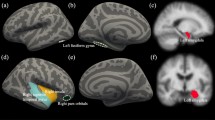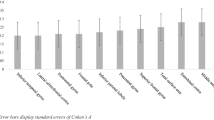Abstract
Conduct disorder (CD) is a psychiatric disorder in either childhood or adolescence and is characterized by aggressive and antisocial behavior. Although CD has been shown to be associated with structural abnormalities by structural magnetic resonance imaging (sMRI), the classification ability of these structural abnormalities’ spatial patterns remains unclear. The aim of the present study was to characterize these different spatial patterns, which may eventually serve as potential reliable imaging biomarkers in the classification of CD from healthy controls (HCs). High-resolution 3D sMRI was acquired from 60 CD and 60 HCs, and all subjects were male participants. The mean (standard deviation) age was 15.3 (1.0) years old and 15.5 (0.7) years old for the CD and HC group respectively. Multivoxel pattern analysis (MVPA) with searchlight algorithm combined with support vector machine (SVM) was used to characterize the different spatial patterns in grey matter (GM) and to assess the classification ability of such structural difference. Seven cortical and subcortical regions showed significant GM difference between CD and HCs, including the cerebellum posterior lobe, temporal lobe, parahippocampal gyrus, lingual gyrus, insula, parietal lobe and medial frontal gyrus. GM in these brain regions discriminated CD with accuracy of up to 83%. Multiple brain regions exhibited aberrantly different spatial patterns in CD. The spatial patterns might be objective and reliable imaging features that could help to improve the classification of CD.

Similar content being viewed by others
References
Arnsten, A. F., & Rubia, K. (2012). Neurobiological circuits regulating attention, cognitive control, motivation, and emotion: Disruptions in neurodevelopmental psychiatric disorders [J]. Journal of the American Academy of Child and Adolescent Psychiatry, 51(4), 356–367.
Ashburner, J. (2009). Computational anatomy with the SPM software [J]. Magnetic Resonance Imaging, 27(8), 1163–1174.
Ashburner, J., & Friston, K. (2000). Voxel-based morphometry—The methods [J]. Neuroimage, 11(6 Pt 1), 805–821.
Barkataki, I., Kumari, V., Das, M., Taylor, P., & Sharma, T. (2006). Volumetric structural brain abnormalities in men with schizophrenia or antisocial personality disorder [J]. Behavioural Brain Research, 169(2), 239–247.
Berlucchi, G., & Aglioti, S. (1997). The body in the brain: Neural bases of corporeal awareness [J]. Trends in Neurosciences, 20(12), 560–564.
Budhiraja, M., Savic, I., Lindner, P., Jokinen, J., Tiihonen, J., & Hodgins, S. (2017). Brain structure abnormalities in young women who presented conduct disorder in childhood/adolescence [J]. Cognitive, Affective, & Behavioral Neuroscience, 17(4), 869–885.
Buitelaar, J. K., Smeets, K. C., Herpers, P., Scheepers, F., Glennon, J., & Rommelse, N. N. J. (2013). Conduct disorders [J]. European Child & Adolescent Psychiatry, 22(1), 49–54.
Bussing, R., Grudnik, J., Mason, D., Wasiak, M., & Leonard, C. (2002). ADHD and conduct disorder: An MRI study in a community sample [J]. The World Journal of Biological Psychiatry, 3(4), 216–220.
Cappadocia, M. C., Desrocher, M., Pepler, D., & Schroeder, J. H. (2009). Contextualizing the neurobiology of conduct disorder in an emotion dysregulation framework [J]. Clinical Psychology Review, 29(6), 506–518.
Craig, A. D. (2002). How do you feel? Interoception: The sense of the physiological condition of the body [J]. Nature Reviews. Neuroscience, 3(8), 655–666.
Dalwani, M., Sakai, J. T., Mikulich-Gilbertson, S. K., Tanabe, J., Raymond, K., McWilliams, S. K., Thompson, L. L., Banich, M. T., & Crowley, T. J. (2011). Reduced cortical gray matter volume in male adolescents with substance and conduct problems [J]. Drug and Alcohol Dependence, 118(2–3), 295–305.
Dalwani, M. S., McMahon, M. A., Mikulich-Gilbertson, S. K., Young, S. E., Regner, M. F., Raymond, K. M., McWilliams, S. K., Banich, M. T., Tanabe, J. L., Crowley, T. J., & Sakai, J. T. (2015). Female adolescents with severe substance and conduct problems have substantially less brain gray matter volume [J]. PLoS One, 10(5), e0126368.
De Brito, S. A., et al. (2009). Size matters: Increased grey matter in boys with conduct problems and callous-unemotional traits [J]. Brain, 132(Pt 4), 843–852.
Decety, J., Michalska, K. J., Akitsuki, Y., & Lahey, B. B. (2009). Atypical empathic responses in adolescents with aggressive conduct disorder: A functional MRI investigation [J]. Biological Psychology, 80(2), 203–211.
Fairchild, G., Passamonti, L., Hurford, G., Hagan, C. C., von dem Hagen, E. A. H., van Goozen, S. H. M., Goodyer, I. M., & Calder, A. J. (2011). Brain structure abnormalities in early-onset and adolescent-onset conduct disorder [J]. The American Journal of Psychiatry, 168(6), 624–633.
Gasquoine, P. G. (2014). Contributions of the insula to cognition and emotion [J]. Neuropsychology Review, 24(2), 77–87.
Good, C. D., Johnsrude, I. S., Ashburner, J., Henson, R. N. A., Friston, K. J., & Frackowiak, R. S. J. (2001). A voxel-based morphometric study of ageing in 465 normal adult human brains [J]. NeuroImage, 14(1), 21–36.
Haubold, A., Peterson, B. S., & Bansal, R. (2012). Annual research review: Progress in using brain morphometry as a clinical tool for diagnosing psychiatric disorders [J]. Journal of Child Psychology and Psychiatry, 53(5), 519–535.
Huebner, T., et al. (2008). Morphometric brain abnormalities in boys with conduct disorder [J]. Journal of the American Academy of Child and Adolescent Psychiatry, 47(5), 540–547.
Hyatt, C. J., Haney-Caron, E., & Stevens, M. C. (2012). Cortical thickness and folding deficits in conduct-disordered adolescents [J]. Biological Psychiatry, 72(3), 207–214.
Jiang, Y., Guo, X., Zhang, J., Gao, J., Wang, X., Situ, W., Yi, J., Zhang, X., Zhu, X., Yao, S., & Huang, B. (2015). Abnormalities of cortical structures in adolescent-onset conduct disorder [J]. Psychological Medicine, 45(16), 3467–3479.
Klapwijk, E. T., Lelieveld, G. J., Aghajani, M., Boon, A. E., van der Wee, N. J. A., Popma, A., Vermeiren, R. R. J. M., & Colins, O. F. (2016). Fairness decisions in response to emotions: A functional MRI study among criminal justice-involved boys with conduct disorder [J]. Social Cognitive and Affective Neuroscience, 11(4), 674–682.
Kruesi, M. J., et al. (2004). Reduced temporal lobe volume in early onset conduct disorder [J]. Psychiatry Research, 132(1), 1–11.
Lenroot, R. K., & Giedd, J. N. (2006). Brain development in children and adolescents: Insights from anatomical magnetic resonance imaging [J]. Neuroscience & Biobehavioral Reviews, 30(6), 718–729.
Liu, F., Guo, W., Yu, D., Gao, Q., Gao, K., Xue, Z., du, H., Zhang, J., Tan, C., Liu, Z., Zhao, J., & Chen, H. (2012). Classification of different therapeutic responses of major depressive disorder with multivariate pattern analysis method based on structural MR scans [J]. PLoS One, 7(7), e40968.
Lu, F.-M., Zhou, J. S., Zhang, J., Xiang, Y. T., Zhang, J., Liu, Q., Wang, X. P., & Yuan, Z. (2015). Functional connectivity estimated from resting-state fMRI reveals selective alterations in male adolescents with pure conduct disorder [J]. PLoS One, 10(12), e0145668.
Michalska, K. J., Decety, J., Zeffiro, T. A., & Lahey, B. B. (2015). Association of regional gray matter volumes in the brain with disruptive behavior disorders in male and female children [J]. Neuroimage Clin, 7, 252–257.
Michalska, K. J., Zeffiro, T. A., & Decety, J. (2016). Brain response to viewing others being harmed in children with conduct disorder symptoms [J]. Journal of Child Psychology and Psychiatry, 57(4), 510–519.
Mohanty, A., et al. (2008). The Spatial Attention Network Interacts with Limbic and Monoaminergic Systems to Modulate Motivation-Induced Attention Shifts [J]. Cerebral Cortex (New York, NY), 18(11), 2604–2613.
Muller, J. L., et al. (2008). Gray matter changes in right superior temporal gyrus in criminal psychopaths. Evidence from voxel-based morphometry [J]. Psychiatry Research, 163(3), 213–222.
Norman, K. A., Polyn, S. M., Detre, G. J., & Haxby, J. V. (2006). Beyond mind-reading: Multi-voxel pattern analysis of fMRI data [J]. Trends in Cognitive Sciences, 10(9), 424–430.
Park, S. H., & Han, K. (2018). Methodologic guide for evaluating clinical performance and effect of artificial intelligence Technology for Medical Diagnosis and Prediction [J]. Radiology, 286(3), 171920.
Pereira, F., Mitchell, T., & Botvinick, M. (2009). Machine learning classifiers and fMRI: A tutorial overview [J]. Neuroimage, 45(1 Suppl), S199–S209.
Raine A, The psychopathology of crime: Criminal behavior as a clinical disorder [M]. Elsevier 2013.
Raine, A., & Yang, Y. (2006). Neural foundations to moral reasoning and antisocial behavior [J]. Social Cognitive and Affective Neuroscience, 1(3), 203–213.
Rogers, J. C., & De Brito, S. A. (2016). Cortical and subcortical gray matter volume in youths with conduct problems: A meta-analysis [J]. JAMA Psychiatry, 73(1), 64–72.
Rubia, K. (2011). Cool inferior frontostriatal dysfunction in attention-deficit/hyperactivity disorder versus "hot" ventromedial orbitofrontal-limbic dysfunction in conduct disorder: A review [J]. Biological Psychiatry, 69(12), e69–e87.
Rubia, K., et al. (2008). Dissociated functional brain abnormalities of inhibition in boys with pure conduct disorder and in boys with pure attention deficit hyperactivity disorder [J]. The American Journal of Psychiatry, 165(7), 889–897.
Rubia, K., et al. (2009). Disorder-specific dissociation of orbitofrontal dysfunction in boys with pure conduct disorder during reward and ventrolateral prefrontal dysfunction in boys with pure ADHD during sustained attention [J]. The American Journal of Psychiatry, 166(1), 83–94.
Sasayama, D., Hayashida, A., Yamasue, H., Harada, Y., Kaneko, T., Kasai, K., Washizuka, S., & Amano, N. (2010). Neuroanatomical correlates of attention-deficit-hyperactivity disorder accounting for comorbid oppositional defiant disorder and conduct disorder [J]. Psychiatry and Clinical Neurosciences, 64(4), 394–402.
Silani, G., Lamm, C., Ruff, C. C., & Singer, T. (2013). Right supramarginal gyrus is crucial to overcome emotional egocentricity bias in social judgments [J]. The Journal of Neuroscience, 33(39), 15466–15476.
Sterzer, P., Stadler, C., Poustka, F., & Kleinschmidt, A. (2007). A structural neural deficit in adolescents with conduct disorder and its association with lack of empathy [J]. Neuroimage, 37(1), 335–342.
Stevens, M. C., & Haney-Caron, E. (2012). Comparison of brain volume abnormalities between ADHD and conduct disorder in adolescence [J]. Journal of Psychiatry & Neuroscience: JPN, 37(6), 389–398.
Uddin, L. Q., Menon, V., Young, C. B., Ryali, S., Chen, T., Khouzam, A., Minshew, N. J., & Hardan, A. Y. (2011). Multivariate searchlight classification of structural magnetic resonance imaging in children and adolescents with autism [J]. Biological Psychiatry, 70(9), 833–841.
Wu, Q., Zhang, X., Dong, D., Wang, X., & Yao, S. (2017). Altered spontaneous brain activity in adolescent boys with pure conduct disorder revealed by regional homogeneity analysis [J]. European Child & Adolescent Psychiatry, 26(7), 827–837.
Yao, S., Yang, H., Zhu, X., Auerbach, R. P., Abela, J. R. Z., Pulleyblank, R. W., & Tong, X. (2007). An examination of the psychometric properties of the Chinese version of the Barratt impulsiveness scale, 11th version in a sample of Chinese adolescents [J]. Perceptual and Motor Skills, 104(3 Pt 2), 1169–1182.
Zhang, J., et al. (2018). Distinguishing Adolescents With Conduct Disorder From Typically Developing Youngsters Based on Pattern Classification of Brain Structural MRI [J]. Frontiers in Human Neuroscience, 12(152).
Zhou, J., Yao, N., Fairchild, G., Zhang, Y., & Wang, X. (2015). Altered hemodynamic activity in conduct disorder: A resting-state FMRI investigation [J]. PLoS One, 10(3), e0122750.
Acknowledgements
The study was funded by the Natural Science Foundation of China (No. 81471384) and the Seed Funding from Scientific and Technical Innovation Council of Shenzhen Government (No. 000048).
Author information
Authors and Affiliations
Corresponding authors
Ethics declarations
Financial disclosures
None of the authors has any conflicts of interest to disclosure. We confirm that we have read the Journal’s position on issues involved in ethical publication and affirm that this report is consistent with those guidelines.
Rights and permissions
About this article
Cite this article
Zhang, J., Cao, W., Wang, M. et al. Multivoxel pattern analysis of structural MRI in children and adolescents with conduct disorder. Brain Imaging and Behavior 13, 1273–1280 (2019). https://doi.org/10.1007/s11682-018-9953-6
Published:
Issue Date:
DOI: https://doi.org/10.1007/s11682-018-9953-6




